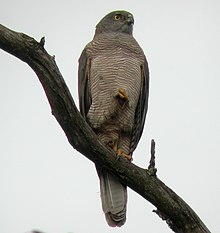Accipiter: Difference between revisions
Idioma-bot (talk | contribs) m r2.7.2) (Robot: Adding lez:Чинеруг |
m r2.7.3) (Robot: Adding sl:Jastreb, Danilovgrad |
||
| Line 127: | Line 127: | ||
[[pt:Accipiter]] |
[[pt:Accipiter]] |
||
[[ru:Настоящие ястребы]] |
[[ru:Настоящие ястребы]] |
||
[[sl:Jastreb, Danilovgrad]] |
|||
[[cu:Ꙗстрѧбъ]] |
[[cu:Ꙗстрѧбъ]] |
||
[[sr:Јастребови]] |
[[sr:Јастребови]] |
||
Revision as of 15:06, 5 May 2012
| Accipiter | |
|---|---|

| |
| Collared Sparrowhawk (A. cirrocephalus), Kobble Creek (Queensland, Australia) | |
| Scientific classification | |
| Kingdom: | |
| Phylum: | |
| Class: | |
| Subclass: | |
| Infraclass: | |
| Superorder: | |
| Order: | |
| Family: | |
| Subfamily: | |
| Genus: | Accipiter Brisson, 1760
|
| Diversity | |
| [[#Species in taxonomic order|About 50 species]] | |
| Synonyms | |
|
Hieraspiza Kaup, 1844 (but see text) | |
The genus Accipiter is a group of birds of prey in the family Accipitridae, many of which are named as goshawks and sparrowhawks. They can be anatomically distinguished from their relatives by the lack of a procoracoid foramen. Two small and aberrant species usually placed here do possess a large procoracoid foramen and are also distinct as regards DNA sequence. They may warrant separation in the old genus Hieraspiza.[1]
These birds are slender with short broad rounded wings and a long tail which helps them manoeuvre in flight. They have long legs and long sharp talons used to kill their prey, and a sharp hooked bill used in feeding. Females tend to be larger than males. They often ambush their prey, mainly small birds and mammals, capturing it after a short chase. The typical flight pattern is a series of flaps followed by a short glide. They are commonly found in wooded or shrubby areas.
Species in taxonomic order
- Northern Goshawk, Accipiter gentilis
- Eurasian Sparrowhawk, Accipiter nisus
- Grey-bellied Hawk, Accipiter poliogaster
- Crested Goshawk, Accipiter trivirgatus
- Sulawesi Goshawk, Accipiter griseiceps
- Red-chested Goshawk, Accipiter toussenelii
- African Goshawk, Accipiter tachiro
- Chinese Sparrowhawk, Accipiter soloensis
- Frances's Sparrowhawk, Accipiter francesiae
- Anjouan Sparrowhawk, Accipiter francesiae pusillus
- Spot-tailed Sparrowhawk, Accipiter trinotatus
- Grey Goshawk, Accipiter novaehollandiae
- Brown Goshawk, Accipiter fasciatus
- Christmas Goshawk, Accipiter (fasciatus) natalis
- Black-mantled Goshawk, Accipiter melanochlamys
- Pied Goshawk, Accipiter albogularis
- Fiji Goshawk, Accipiter rufitorques
- White-bellied Goshawk, Accipiter haplochrous
- Moluccan Goshawk, Accipiter henicogrammus
- Grey-headed Goshawk, Accipiter poliocephalus
- New Britain Goshawk, Accipiter princeps
- Black Sparrowhawk, Accipiter melanoleucus
- Henst's Goshawk, Accipiter henstii
- Meyer's Goshawk, Accipiter meyerianus
- Chestnut-flanked Sparrowhawk, Accipiter castanilius


- Nicobar Sparrowhawk, Accipiter butleri
- Levant Sparrowhawk, Accipiter brevipes
- Slaty-mantled Goshawk, Accipiter luteoschistaceus
- Imitator Goshawk, Accipiter imitator
- Red-thighed Sparrowhawk, Accipiter erythropus
- Little Sparrowhawk, Accipiter minullus
- Japanese Sparrowhawk, Accipiter gularis
- Dwarf Sparrowhawk, Accipiter nanus
- Rufous-necked Sparrowhawk, Accipiter erythrauchen
- Collared Sparrowhawk, Accipiter cirrocephalus
- New Britain Sparrowhawk, Accipiter brachyurus
- Vinous-breasted Sparrowhawk, Accipiter rhodogaster
- Madagascar Sparrowhawk, Accipiter madagascariensis
- Ovambo Sparrowhawk, Accipiter ovampensis
- Rufous-chested Sparrowhawk, Accipiter rufiventris
- Shikra, Accipiter badius
- Tiny Hawk, Accipiter superciliosus – may belong in Hieraspiza
- Semicollared Hawk, Accipiter collaris – may belong in Hieraspiza
- Sharp-shinned Hawk, Accipiter striatus
- White-breasted Hawk, Accipiter striatus chionogaster
- Plain-breasted Hawk, Accipiter striatus ventralis
- Rufous-thighed Hawk, Accipiter striatus erythronemius
- Cooper's Hawk, Accipiter cooperii
- Gundlach's Hawk, Accipiter gundlachi
- Bicolored Hawk, Accipiter bicolor
- Chilean Hawk, Accipiter (bicolor) chilensis
- Besra, Accipiter virgatus
An Accipiter was seen on 12 March 1994 south of the summit of Camiguin in the Philippines, where the genus was not known to occur. It may have been an undescribed taxon, but more likely it was not; it could simply have been a vagrant of a known species.[2]
Footnotes
References
- Balete, Danilo S.; Tabaranza, Blas R. Jr. & Heaney, Lawrence R. (2006): An Annotated Checklist of the Birds of Camiguin Island, Philippines. Fieldiana Zool. New Series 106: 58–72. DOI:10.3158/0015-0754(2006)106[58:AACOTB]2.0.CO;2 HTML abstract
- Heaney, Lawrence R. & Tabaranza, Blas R. Jr. (2006): Mammal and Land Bird Studies on Camiguin Island, Philippines: Background and Conservation Priorities. Fieldiana Zool. New Series 106: 1-13. DOI:10.3158/0015-0754(2006)106[1:MALBSO]2.0.CO;2 HTML abstract
- Olson, Storrs L. (2006): Reflections on the systematics of Accipiter and the genus for Falco superciliosus Linnaeus. Bull. B.O.C. 126: 69-70. PDF fulltext
